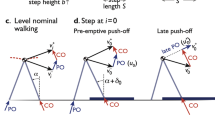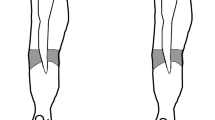Abstract
Anticipatory adjustments of our locomotor patterns are necessary in order to negotiate our uneven daily environments. Recent work (McFadyen and Winter 1991) has shown the re-organization of lower limb mechanics for obstacle avoidance during level walking. The present work describes a model which sets the ground work for predicting how such re-organized motor patterns might be generated from stereotypic unobstructed patterns. Pattern-generating algorithms use an estimation of future contacts with obstacles to create weighting functions that modify joint angle trajectories towards new patterns capable of clearing the obstacle. Feedforward/feedback control is then used to generate the necessary joint torques. The results show that model parameters can be found to generate not only kinematic but also energetic patterns for obstacle clearance that mimic experimental results. The validity of the model with respect to human locomotor control is discussed.
Similar content being viewed by others
Explore related subjects
Discover the latest articles and news from researchers in related subjects, suggested using machine learning.References
Beloozerova IN, Sirota MG (1993) The role of the motor cortex in the control of accuracy of locomotor movements in the cat. J Physiol 461:1–25
Bernstein N (1967) The co-ordination and regulation of movements. Pergamon, Oxford
Beuter A, Flashner H, Arabyan A (1986) Phase plane mode. Biol Cybern 53:273–284
Brooks VB (1986) The neural basis of motor control. Oxford University Press
Bullock D, Grossberg S (1988) Neural dynamics of planned arm movements: emergent invariants and speed-accuracy properties during trajectory formation. Psychol Rev 95:49–90
Chen HC, Ashton-Miller JA, Alexander NB, Schultz AB (1991) Stepping over obstacles: gait patterns of healthy young and old adults. J Gerontol Med Sci 46:196–203
Dempster WT (1955) Space requirements of the seated operator. Wright Patterson Air Force Base, WADC-RT-55-159
Drew T (1993) Motor cortical activity during voluntary gait modifications in the cat. I. Cells related to the forelimbs. J Neurophysiol 70:179–199
Flashner H, Beuter A, Arabyan A (1986) Modeling of control and learning in a stepping motion. Biol Cybern 55:10–16
Flashner H, Beuter A, Arabyan A (1988) Fitting mathematical functions to joint kinematics during stepping: implications for motor control. Biol Cybern 58:91–99
Flowers K (1978) The predictive control of behaviour: appropriate and inappropriate actions beyond the input in a tracking task. Ergonomics 21:109–122
Forssberg H, Grillner S, Halbertsma J (1980) The locomotion of the low spinal cat. I. Coordination within a hindlimb. Acta Physiol Scand 108:269–281
Ghez C (1991) Voluntary movement. In: Kandel E, Schwartz J, Jessell T (eds) Principles of neural science. Appleton & Lange, New York, pp 609–625
Ghez C, Gordon J, Ghilardi MF, Christakos CN, Cooper SE (1990)Roles of proprioceptive input in the programming of arm trajectories. Cold Spring Harb Symp Quant Biol 55:837–847
Houk JC, Gibson AR (1987) Sensorimotor processing through the cerebellum. In: King JS (ed) New concepts in cerebellar neurobiology. Liss, New York, pp 387–417
Hreljac A (1993) The relationship between smoothness and performance during the practice of a lower limb obstacle avoidance task. Biol Cybern 68:375–379
Jagacinski R, Miller R (1978) Describing the human operator's internal model of a dynamic system. Human Factors 20:425–433
Jordan MI (1990) Motor learning and the degrees of freedom problem. In: Jeannerod M (ed) Attention and performance XIII. Erlbaum, Hillsdale, pp 796–836
Kawato M, Gomi H (1992) A computational model of four regions of the cerebellum based on feedback-error-learning. Biol Cybern 68:95–103
Kawato M, Furukawa K, Suzuki R (1987) A hierarchical neural-network model for control and learning of voluntary movement. Biol Cybern 57:169–185
Klir G (1985) Architecture of systems problem solving. Plenum, New York
McFadyen BJ, Winter DA (1988) An integrated biomechanical analysis of normal stair ascent and descent. J Biomech 21:1–12
McFadyen BJ, Winter DA (1991) Anticipatory locomotor adjustments during obstructed human walking. Neurosci Res Commun 9:37–44
McFadyen BJ, Magnan GA, Boucher JP (1993) The anticipatory locomotor adjustments for avoiding visible fixed obstacles of varying proximity. Hum Mov Sci 12:259–272
Mena D, Mansour J, Simon S (1981) Analysis and synthesis of human swing leg motion during gait and its clinical applications. J Biomech 14:823–832
Milner-Brown HS, Stein RB, Yemm R (1973) The contractile properties of human motor units during voluntary isometric contractions. J Physiol 228:285–306
Olney S, Winter DA (1985) Predictions of knee and ankle moments of force in walking from EMG and kinematic data. J Biomech 18:9–20
Patla A, Beuter A, Prentice S (1991) A two stage correction of limb trajectory to avoid obstacles during stepping. Neurosci Res Commun 8:153–159
Rosen R (1985) Anticipatory systems: philosophical, mathematical and methodological foundations. Pergamon, Toronto
Searle J (1984) Minds, brains and science. Harvard University Press, Cambridge, Mass.
Taga G, Yamaguchi Y, Shimzu H (1991) Self organized control and biped locomotion by neural oscillators in unpredictable environments. Biol Cybern 65:147–159
Warren WH (1984) Perceiving affordances: visual guidance of stair climbing. Exp Psychol Hum Percept Perform 10:683–703
Winter DA (1983) Biomechanical motor patterns in normal walking. J Motor Behav 15:302–330
Winter DA (1992) Foot trajectory in human gait: a precise and multifactorial motor control task. Phys Ther 72:45–56
Author information
Authors and Affiliations
Rights and permissions
About this article
Cite this article
McFadyen, B.J., Winter, D.A. & Allard, F. Simulated control of unilateral, anticipatory locomotor adjustments during obstructed gait. Biol. Cybern. 72, 151–160 (1994). https://doi.org/10.1007/BF00205979
Received:
Accepted:
Issue Date:
DOI: https://doi.org/10.1007/BF00205979




